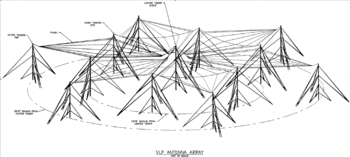Umbrella antenna


An umbrella antenna is a top-loaded electrically lengthened monopole antenna, consisting in most cases of a mast fed at the ground end, to which a number of radial wires are connected at the top, sloping downwards. The outer end of each wire is connected by an insulator to a supporting rope or cable anchored to the ground. The radial wires can also function as guy wires to support the mast. The radial wires make the antenna look like a giant umbrella without the cloth, accounting for the name.
They are used as transmitting antennas below 1 MHz, in the LF and particularly the VLF bands, at frequencies sufficiently low that it is impractical to build a full size quarter-wave monopole antenna. Either the central mast itself, insulated from the ground, is connected to the transmitter and serves as the radiating element, or vertical wires parallel to the mast. At the low frequencies used the height of the mast is typically 1/10 to 1/40 of a wavelength, so it makes a very electrically short antenna, and by itself would have very low radiation resistance and be a very inefficient radiator. The function of the umbrella-wires is to add capacitance to the top of the antenna, improving the current distribution on the vertical mast radiator to increase the radiation resistance and radiated power. The umbrella wires serve as the plate of a capacitor, with the ground serving as the other plate, which is charged and discharged by the radio frequency current from the tramsmitter. Umbrella antennas with heights of 15 to 460 metres are in service. The tallest umbrella antennas are actually used by Lualualei VLF transmitter, INS Kattabomman and the CHAYKA-transmitters at Inta and Dudinka.
Umbrella antennas radiate vertically polarised ground waves in an omnidirectional radiation pattern. Because they are short compared to a wavelength of the radio waves, they have low radiation resistance and are usually inefficient, radiating only a fraction of the power supplied by the transmitter.
Umbrella antennas can be built as single mast antennas or as multiple mast antennas. In first case the wires connected to the top of the antenna mast are fixed at the ground, while in latter case they are fixed at masts arranged around on a circle of the central mast, which are usually smaller than the central mast and often grounded. Umbrella antennas are in common use for commercial medium-wave AM broadcasting as well as for LF and VLF transmitters for broadcasting and navigational aids. They were used at most OMEGA Navigation System transmitters, operating around 10 kHz, and at LORAN-C stations, operating at 100 kHz with central masts approximately 200 metres tall. Eight umbrella antennas 350 metres high are in use in an array at the German VLF communications facility, operating at about 20 kHz with high radiation efficiency even though they are less than 1/40 wavelength high.



Umbrella antennas were invented during the wireless telegraphy era, about 1900 to 1920, and used with spark-gap transmitters on longwave bands to transmit information by Morse code. Small umbrella antennas were widely used with portable transmitters by military signal corps during World War I, since there was no possibility of setting up full-sized quarter-wave antennas.
It is also possible to build an umbrella antenna with a grounded tower. Such an antenna requires a separate feeder to the umbrella wires, which are also insulated against the mast and the ground.